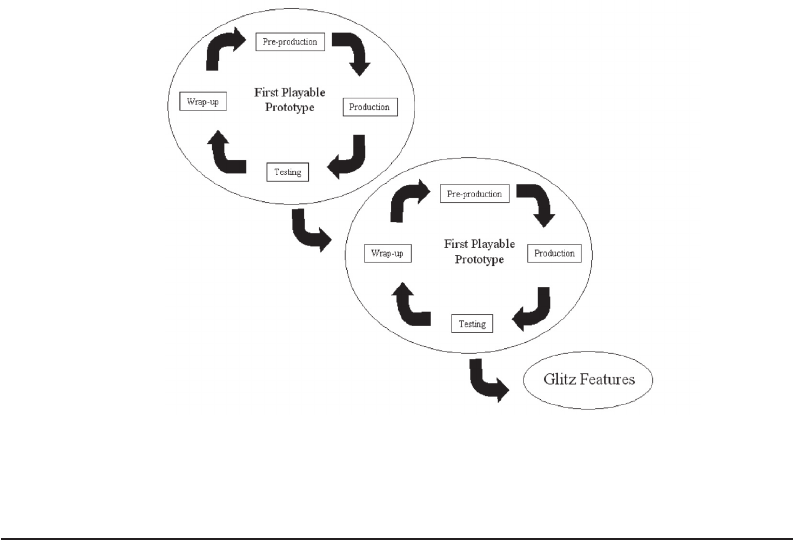
In This Chapter
• Introduction
• Production Cycle
• Pre-Production
• Production
• Testing
• Post-Production
1.1 I
NTRODUCTION
I
f you are a newly minted producer or lead, you are probably wondering
what you’ve gotten yourself into. Even though you are likely to get assistance
along the way from your boss, your publisher, and your team, the burden
of responsibility for getting a game created and code released rests squarely on
your shoulders. These days, as budgets are rising and teams are getting larger,
producers and leads responsible for a project must have a solid understanding
of the game production process, how all the variables involved fit together, and
how to modify the process to fit the needs of their games.
The production process begins with defining the initial game concept and
ends with creating a gold master of the final game code, with everything else
happening in-between. The process differs from project to project, which is
one reason why game production can be challenging to manage. One developer
might have a small team of 15 people working on a web-based game, but another
GAME PRODUCTION
O
VERVIEW
Chapter 1

4 THE GAME PRODUCTION HANDBOOK, 2/E
developer might have more than 100 people working on a console game based
on a well-known movie license.
Regardless of the size of the team, scope of the game, the budget, or other
variables, a basic framework exists for the overall production process. The pro-
cess can be broken down into four broad phases: pre-production, production,
testing, and post-production. Within each of these phases, several goals must be
accomplished before moving on to the next phase. The successful completion of
each phase directly affects the successful release of the game.
1.2 PRODUCTION CYCLE
Figure 1.1 serves as an overview of the basic production cycle. Specific game
production tasks, such as recording voiceover, creating character models, and
debugging multiplayer code are not indicated, as these tasks will vary from proj-
ect to project. The diagram depicts the general goals of each phase and how the
success of each phase builds upon the completion of the previous phase. As you
can see, detailing the project plan in pre-production is important as it provides
a solid foundation upon which to build the game. A project that does not define
a plan in pre-production is likely to encounter several problems that could have
been avoided or prepared for in advance.
It is important to note that this diagram outlines a very basic view of the
game production cycle and that some games, especially as the stakes get higher,
will go through an iterative production process with numerous production cycles.
FIGURE 1.1 Basic game production cycle.

GAME PRODUCTION OVERVIEW 5
For example, if you plan to create a working proof of concept for your game—
a fully polished playable level—you will want to include a few game develop-
ment cycles in the entire production process, with the first cycle consisting of
pre-production, production, and testing of the prototype; the second phase fo-
cusing on the core set of features and assets for the game; and a third cycle creat-
ing and adding any “glitz” features and assets, such as extra levels. Figure 1.2 is
a diagram of multiple production cycles for a single project.
FIGURE 1.2 Multiple production cycles for a single project.
1.3 PRE-PRODUCTION
Pre-production is the first phase in the production cycle and is critical to de-
fining what the game is, how long it will take to make, how many people are
needed, and how much everything will cost. Pre-production can last anywhere
from one week to more than a year, depending on how much time you have to
complete the game. One rule of thumb is that pre-production requires about
10 to 25 percent of the total development time of a game. So if you are working
on a six-month project, pre-production will last from a few weeks to a month.
If you are working on a two-year project, pre-production will last anywhere from
two to six months.
The overriding goal of pre-production is essentially to create the game plan,
which is a roadmap for finishing the game and releasing code. The plan must
6 THE GAME PRODUCTION HANDBOOK, 2/E
include information on the game’s concept, the features and constraints that
affect this concept, the basic technical and design documentation, and finally,
how much it will cost, how long it will take, and how many people, with what
skills, will be needed. Pre-production can be broken down into the following
components: concept, game requirements, game plan, and risk assessment.
Game Concept
Jim Lewis, author of numerous books on project management, suggests thinking
about the concept as finding a solution to a problem. Therefore, a game concept
that starts off as a question, presents a problem to be solved. Would it be fun to
play cowboys and Indians in space? What would it be like to race concept cars?
After the game’s initial concept is determined, usually by studio management or
your publisher, it is passed on to the development team as a problem to solve.
Many concepts start off fuzzy, and the core development team must then
flesh them out so that everyone can easily understand what the goals of the prod-
uct are and what major gameplay elements are needed to support and strengthen
it. For example, if you are working on a realistic tactical military shooter, it would
not fit within the game world to use fictitious alien technology. The concept also
defines the game genre and hardware platform, as these decisions will shape
how the concept grows. When the concept is determined, you must clearly com-
municate it to the rest of the team, so they understand and can get excited about
it. This communication can be done by defining a mission statement.
A mission statement gets everyone excited about the game on which they are
working. The mission statement answers what is going to be done and for whom
it is being done. Short and sweet, something that everyone can remember—
the mission statement is the team’s “elevator speech.” The whole team should
be involved in defining and shaping the mission statement, giving everyone a
stake in the project. This sense of ownership is imperative to building a strong
team. Keep in mind that the mission statement doesn’t need to state “how” these
things will be done, as the “how” will be addressed when the project plan is put
together.
After determining the initial concept, the next step is to add the basic game-
play elements. Initial thoughts on the gameplay mechanics, the control scheme,
the genre, the story, the characters, and other hooks that will set the game apart
from the competition should be included. Prototyping the elements helps to
further define the game experience. Prototypes can start off on paper, and as
the ideas develop more fully, playable prototypes will be created. If possible, try
to create a polished prototype that will be representative of the final gameplay
experience.
As these concepts are further detailed, conduct a risk analysis to determine
the game production’s biggest risks. At this point, several unknowns exist, so
GAME PRODUCTION OVERVIEW 7
it will be difficult to determine specific risks. However, if a few constants are
already defined, like the team size or technology, they can be used as the basis
for an initial risk analysis. If you don’t take time to define the development risks,
you are likely to encounter unexpected problems on the project that could have
been minimized if they were identified as risks early on.
After the concept is fully defined and a prototype is created, you will pitch
it to studio management and the publisher. This pitch provides them the op-
portunity to see how the team has planned to create a solid game from the
initial concept. They will likely have feedback on the pitch, which will need to
be incorporated by the team. If they like what they hear, they will approve the
game for further pre-production. When this approval occurs, the producer will
organize an official project kick-off to present the fully approved concept to the
team.
Chapter 14, “Game Concept,” discusses the concept phase in more detail. After
the concept is defined, the next step is to figure out the game’s re quirements.
Game Requirements
Game requirements include the basic art, design, and engineering features that
must be supported, any constraints on the project, and basic technical and de-
sign documentation. The features must all fit within the established concept and
mission statement.
The team members should be involved in determining the core feature set
and prioritizing the other features so they can develop a sense of ownership of
the game. The feature set should include some unique elements that set it apart
from other games. One way to do this is by having the team brainstorm “must
have,” “want to have,” and “would be nice to have” features, discuss them, and
then create a final prioritized feature set. Chapter 15, “Game Requirements,”
presents one method for doing this.
Constraints should be considered when determining the feature set priori-
ties. For example, everyone may agree that building a new graphics engine is
a “must-have” feature, but if there is not ample time to build the engine, this
feature will be dropped down to a “would be nice to have” feature, and the team
must figure out other ways to achieve the graphic goals for the game.
After the feature set is defined and fits within the constraints, the milestones
and deliverables for each milestone are defined. Some projects are scheduled
around monthly milestones, and other projects are scheduled around first
playable, alpha, and beta milestones. Either method will work, as long as the
deliverables expected at each milestone are clearly defined and published to the
team. Deliverables refer to elements in the game, such as art assets, technical
features, and level scripting, that demonstrate gameplay and the look and feel of
the game universe.
..................Content has been hidden....................
You can't read the all page of ebook, please click here login for view all page.
